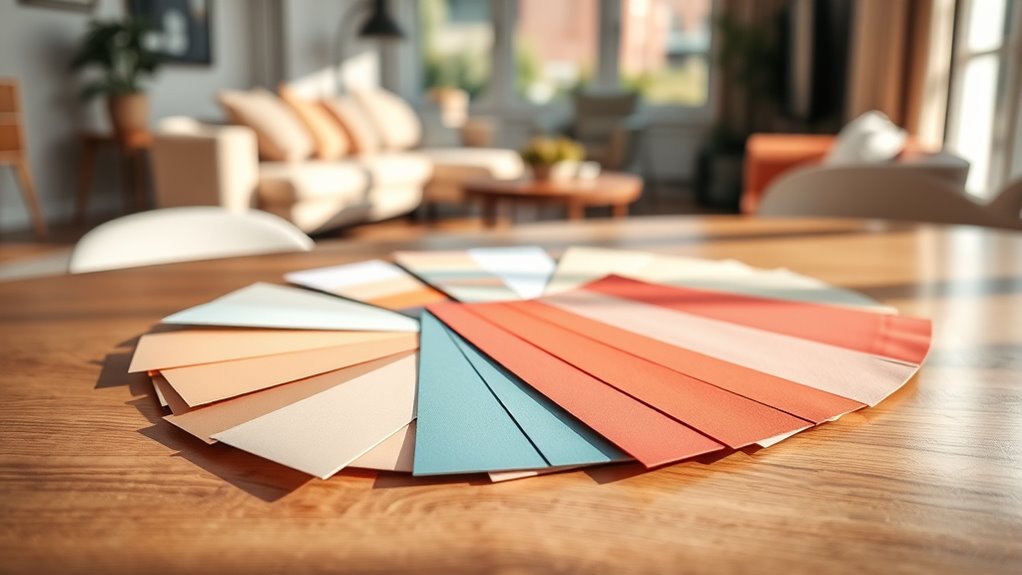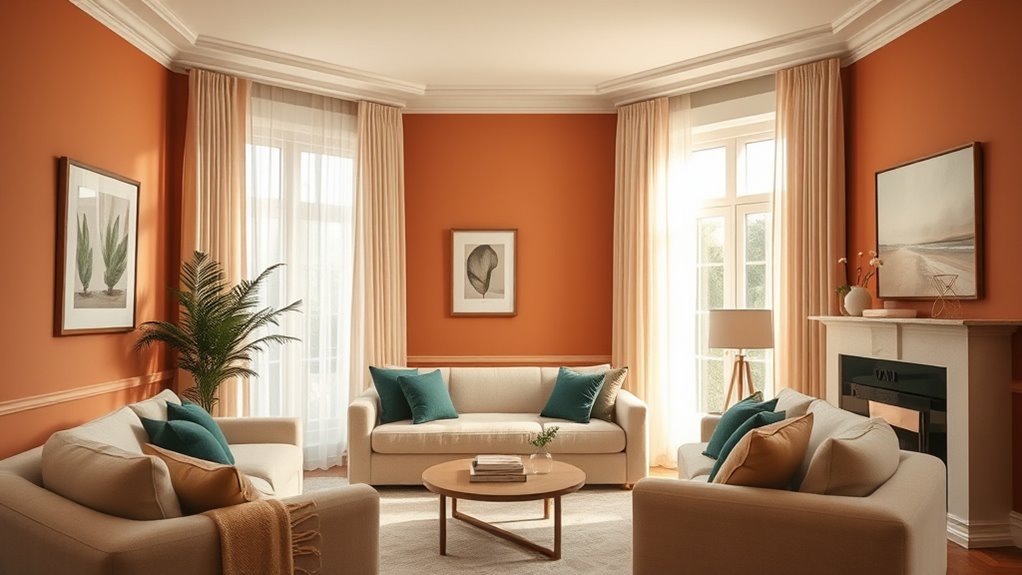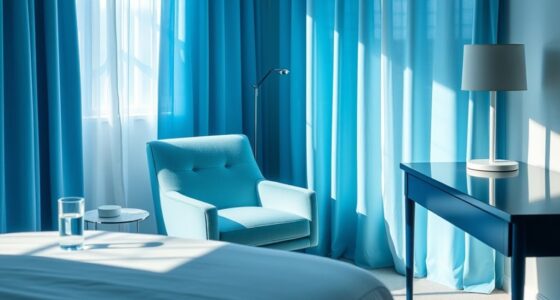When selecting home color palettes, it’s essential to consider color psychology to create a balanced and emotionally resonant space. Choose soothing blues and greens to promote relaxation, while vibrant reds and oranges energize your environment. Balance warm and cool tones for harmony, and use contrast thoughtfully to add visual interest. By understanding how colors influence mood and perception, you’ll craft a home that feels both beautiful and personally meaningful—continue exploring these principles to elevate your interior design.
Key Takeaways
- Choose calming colors like blues and greens to promote relaxation and reduce stress in living spaces.
- Use vibrant reds and oranges to energize rooms meant for social interaction and activity.
- Balance warm and cool tones to create visual harmony and prevent color clashes in your palette.
- Consider how light shades reflect light, making small rooms appear larger and more open.
- Select colors aligned with the emotional tone you want to set, enhancing mood and overall ambiance.

Choosing the right color palette for your home can transform your space and reflect your personal style. When selecting colors, it’s essential to think about how they work together—this is where color harmony comes into play. Color harmony ensures that your chosen shades complement each other, creating a balanced and cohesive look. Imagine walking into a room where the walls, furniture, and accents all feel like they belong together; that’s the power of a well-curated palette. By understanding basic principles of color harmony, you can avoid jarring contrasts and instead craft a space that feels inviting and thoughtfully designed.
Choosing colors that work together creates a balanced, cohesive, and inviting home environment.
Beyond aesthetics, your color choices also influence the mood of each room. Colors have the ability to evoke emotions and set the tone for your daily life. For example, soft blues and greens tend to promote calmness and relaxation, making them perfect for bedrooms or quiet retreats. On the other hand, vibrant reds and oranges can energize a space, ideal for social areas like kitchens or living rooms where you want to foster lively interactions. When you pick colors based on their psychological effects, you’re actively enhancing the mood of your home, making it a more comfortable and inspiring environment for yourself and your loved ones.
It’s also important to take into account how different colors interact within your overall design. Using color theory, you can create palettes that balance warm and cool tones, or contrast bold colors with muted shades for visual interest. For example, pairing a deep navy with soft blush creates a sophisticated yet soothing vibe. If you want to make a small room appear larger, light and airy colors like pastel shades can reflect more light and give a sense of openness. Conversely, darker hues can add coziness and intimacy to larger spaces. When you understand how color harmony and psychological impacts intersect, you gain the tools to craft spaces that are not only beautiful but also aligned with your emotional needs.
Additionally, understanding economic growth factors in Indonesia can provide insights into broader societal trends that influence lifestyle and interior design preferences. Ultimately, selecting a home color palette isn’t just about picking pretty shades—it’s about creating an environment that resonates with you. By paying attention to color harmony and how different hues influence mood, you can design a space that feels just right. So, take your time exploring color combinations, consider the emotional responses you want to evoke, and let your personal style shine through. When your colors work in harmony and support your desired atmosphere, your home becomes a true reflection of your personality and a sanctuary where you feel instinctively at ease.
Frequently Asked Questions
How Do Lighting Conditions Affect Color Perception in a Home?
Lighting conditions greatly influence how you perceive colors in your home. Bright light intensity, whether natural sunlight or artificial lighting, makes colors appear more vibrant and true-to-life. Natural lighting varies throughout the day, while artificial lighting can be adjusted for warmth or coolness. Pay attention to these differences, as they can alter the mood and feel of your space, helping you choose the right colors that look great under all lighting conditions.
Can Color Psychology Influence Mood Differently Across Cultures?
Imagine you’re in a 1920s speakeasy, feeling the tension and excitement. Cultural color symbolism and emotional associations of hues do influence mood differently across cultures. You’ll find that red may symbolize luck in China but danger in the West. Understanding these nuances helps you choose colors that resonate universally or specifically, creating an atmosphere that positively impacts everyone’s mood, regardless of their background.
What Are the Best Color Combinations for Small Spaces?
You should use light, neutral colors to make small spaces feel larger and more open. Incorporate color contrast with darker accents for depth, and consider pattern mixing to add visual interest without overwhelming the room. Keep a balance between bold and subtle elements, avoiding cluttered designs. This approach creates a lively yet spacious atmosphere, making your small space feel welcoming and well-designed.
How Do Personal Experiences Impact Color Preferences?
Your personal experiences shape your color preferences through personal associations and cultural influences. When you connect certain colors with memories or traditions, they become more meaningful and appealing. Cultural backgrounds can also influence which colors you favor or avoid. By understanding these factors, you can choose home colors that resonate with you emotionally, creating a space that feels truly personal and comfortable.
Are There Universal Color Choices for Promoting Relaxation at Home?
Think of calming colors like blue and green as your home’s version of a Zen garden. These hues, rooted in color symbolism and emotional associations, universally promote relaxation. Blue evokes tranquility, while green connects to nature and renewal. While personal preferences vary, sticking to these colors can create a soothing atmosphere, helping you unwind after a busy day. Embrace these choices for a peaceful, inviting space everyone can enjoy.
Conclusion
By choosing your home colors wisely, you can transform your space into a sanctuary that energizes and calms your soul. Remember, the right palette isn’t just a detail—it can be the difference between a house and a home. Trust your instincts and let color psychology guide you; your perfect home environment is just a brushstroke away. Don’t underestimate the power of color—it’s more influential than you think, capable of turning your entire mood around!









